|
|
Search

|
  Home Home
|
  Surname Surname
|
  First Name First Name
|
Popular Products

|
  Coat of Arms Coat of Arms
|
  Clan Badges Clan Badges
|
  Books & Gifts Books & Gifts
|
  Celtic Jewelry Celtic Jewelry
|
  Black Shirts Black Shirts
|
  CD Music CD Music
|
  Download Download
|
 Design Gallery
Design Gallery

|
  Irish Irish
|
  Flags Flags
|
  Celtic Celtic
|
  Tartans Tartans
|
  Scottish Scottish
|
  Claddagh Claddagh
|
  Surnames Surnames
|
  Highlander Highlander
|
  Celtic Radio Celtic Radio
|
Research

|
  History History
|
  Country Country
|
  Families Families
|
|
|
|
|
 We custom design and produce all of our products with industrial press technologies located at our Boston Massachusetts facilities! This industrial process results in superior manufacturing that will outlast even store bought products. Our base products are supplied from a major clothing wholesaler, so we can keep our prices low.
Orders made today are generally filled within 1-4 weeks depending on our current supply schedule. All products have a 30 day money back guarantee for defects in workmanship. Customer satisfaction is our number one priority!
|
|
Our Heraldry Database has thousands of Family histories to search. Visit Now!
MacQueen

Coat of Arms
This Celtic name is also given as ‘Macsween’, or ‘son of Sweyn’. They are accordingly of the same descent as the great Clan Donald, claiming kinship with the Irish High Kings. The Macqueens are said to have provided a guard for a daughter of the house of Clan Ranald who married a Mackintosh chief, and they elected to settle around Findhorn and became part of that confederation of clans known as th.....
|
|
|
Heraldry Database: Macintyre
MacIntyre

|
|
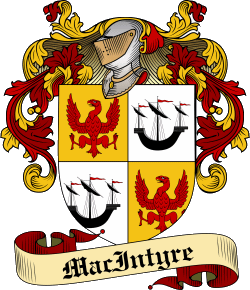

Surname: MacIntyre
Branch: MacIntyre
Origins: Scottish
More Info: Scotland
|
|
Background: The MacIntyres were known as Mac An t-Saoir, meaning the children of the carpenter and came initially from the Hebrides settling in Lorn in the 14th century. It is claimed in an old tradition that the family were formally Macdonald. One day at sea a galley sprung a leak and one of the Macdonalds forced his thumb into the hole and cut it off, thus enabling the boat to reach its destination safely. He was henceforth known as "An t-saoir" and his descendants Macan t-saoir. Whatever the exact origins of the clan they seem to have become established in Glenoe, Argyllshire around 1300, where they became feudal inferiors to the Campbells of Glenorchy. This family were considered the principal branch until 1806 when they were forced to part with their lands and emigrated to America. The MacIntyres were also connected with several other clans, they were hereditary foresters to the Stewarts of Lorn, and ten were killed or wounded in the Appin regiment at Culloden in 1746. A branch of the clan followed the Campbells of Craignish, while another moved to Badenoch, and in 1496 were admitted as a sept of Clan Chattan by William 13th Chief of the MacKintoshes. MacIntyres of Rannoch were hereditary pipers to the Menzies of Weem, while another branch held the same office to the MacDonalds of Clanranald. One of the most famous of Gaelic poets was Duncan MacIntyre, Donnacha Ban nan Oran, born in Glenorchy in 1724. He was imprisoned for a poem he wrote against the Act of Proscription of the Highland dress and died in Edinburgh in 1812. In 1991, James MacIntyre of Glenoe, who lives in the United States of America, was officially recognised by the Lord Lyon as Chief of Clan MacIntyre. Prior to his claim being recognised, the chiefship had been vacant since the 19th century.
|
 Motto: Motto: Per Ardua, Through difficulties. Battle Cry: Cruachan, Ben Cruachan is a mountain between Loch Awe and Loch Etive. Arms: Quarterly, 1st & 4th, Or, an eagle displayed Gules, beaked and membered Sable, charged on the breast with a plate; 2nd, Argent, a lymphad, sails furled, oars in saltire Sable, flagged Gules, with a beacon on top of the most Proper; 34rd, Argent, a sinister hand fessways Gules holding a cross crosslet fitchee Azure. Crest: A dexter hand holding a dagger in pale Proper. Supporters: (on a compartment embellished with white heather) Two cows Argent, langued Gules, hooved Sable. Plant: White heather. View the Heraldry Dictionary for help.

In Gaelic, the name Macintyre is rendered ‘Mac an t-Saoir’, meaning ‘son of the carpenter’. A traditional account dates the origins of the name to the early twelfth century, when Somerled was establishing his lordship in the Western Isles. After Olav the Red, Norse King of Man and the Isles, resisted Somerled’s ambitions, he then resorted to diplomacy, and sought the hand of the king’s daughter, Ragnhild, in marriage. Somerled’s nephew, Macarill or Maurice, assured his uncle that he could devise a scheme to win the bride. It is said that Macarill sabotaged Olav’s galley by boring holes in the hull, which he then plugged with tallow. He contrived to be a passenger on the king’s galley, and went well supplied with wooden plugs. Heavy seas washed out the tallow and the galley began to founder, at which point Macarill promised to save the king’s life if he would promise his daughter’s hand to Somerled. The pact was sealed, and the plugs used to stop the leaks. Macarill was thereafter known as the ‘wright’ or ‘carpenter’, and found high favour with his uncle.
Macarill’s descendants later established themselves on the mainland where, according to legend, they were warned by a spirit only to settle where a white cow in their herd came to rest. The land they settled was the rich and fertile Glen Noe by Ben Cruachan on Loch Etiveside. By the end of the thirteenth century the Macintyres were foresters to the Lord of Lorn, an office they held through the passing of the lordship from the Macdougalls to the Stewarts and finally the Campbells.
As the family records have been lost, the Macintyre chiefs cannot be listed with any accuracy, but the first chief of record was Duncan, who married a daughter of Campbell of Barcaldine. Duncan died in 1695 and was buried in Ardchattan Priory in a tomb worthy of his rank. Through the Barcaldine connection, the Macintyre chiefs claim descent from Robert the Bruce. The civil war in Scotland provided a convenient excuse for many clans to settle old scores. The Earl of Argyll was not only leader of the Covenanter faction in the Scottish Parliament, but he was also the implacable foe of many clans whose fortunes had been eclipsed by the rise of the Campbells. The earl’s lands were ravaged, but royalist forces commanded by Alasdair Macdonald, ‘Colkitto’, spared Glen Noe on the grounds that the Macintyres were kinsmen. Many Macintyres subsequently joined Colkitto’s army, including the chief’s piper. The chief, however, was with Argyll at Inverlochy in February 1645 when the Campbells were surprised by Montrose and routed.
James, the third chief, was born around 1727. He was sponsored by the Campbell Earl of Breadalbane and studied law, being regarded as a good scholar and a poet. On his father’s death he returned to Glen Noe. When Prince Charles Edward Stuart raised his father’s standard at Glenfinnan in 1745, James would have joined him but for the influence of his Campbell wife and neighbours. Many clansmen, however, slipped away and fought under Stewart of Appin at Culloden. The great Macintyre bard, Duncan Ban, fought for the house of Hanover at the Battle of Falkirk in 1746. A monument to the poet’s memory was erected in 1859 near Loch Awe.
The Macintyres originally held their lands by right of the sword, but they had acquired feudal obligations to the Campbells. The payments were purely symbolic until the early eighteenth century, when Campbell of Breadalbane persuaded the Macintyre chief to pay a cash rent. The rent was then progressively raised to a point where Donald, the fourth recorded chief, was unable to pay, and he emigrated to America in 1783, leaving his brother, Duncan, to manage the estate. Duncan struggled on until 1806, when he, too, left the glen. The chiefly line continued to honour their Scottish origins in America, preserving the armorial great seal, signet ring and quaffing cup. In 1955 Alasdair Macintyre of Camus-na-h-erie recorded arms in the Lyon Court as cadet of the chiefly house of Macintyre. The shield was quite different from that which clan historians believed to be correct. This unhappy state of affairs was corrected in 1991, when James Wallace Macintyre of Glenoe, ninth of the recorded chiefs, matriculated the correct undifferenced arms. The Macintyres once more take their seat on the Council of Clan Chiefs, and even Duncan Ban’s lonely monument is more accessible, with a Forestry Commission stopping place from which it may be viewed.
Name Variations: MacIntyre, MacCosham, MacIntire, MacIntyre, MacKintyre, MacTear, MacTier, MacTire, Tyre, Wright
.
References:One or more of the following publications has been referenced for this article.The General Armory; Sir Bernard Burke - 1842.
A Handbook of Mottoes; C.N. Elvin - 1860.
Scottish Clans and Tartans; Neil Grant - 2000.
Scottish Clan and Family Encyclopedia; George Way of Plean and Romilly Squire - 1994.
Scottish Clans and Tartans; Ian Grimble - 1973.
World Tartans; Iain Zaczek - 2001.
Clans and Families of Scotland; Alexander Fulton - 1991.

|
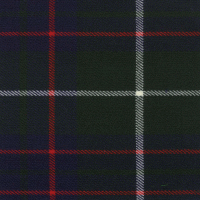
Modern Hunting | 
Modern | 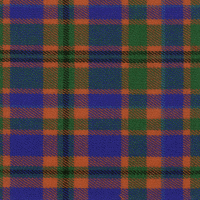
Ancient Glenorchy | 
Ancient Hunting | 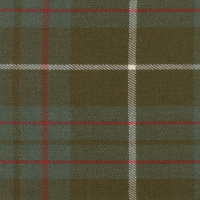
Weathered Hunting |

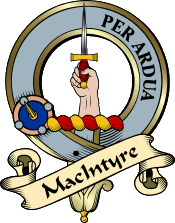


Sign-up for a Founders account and receive personalized
family heraldry service and much more!

Want to know more?
Click the Heart!
|
|
|



